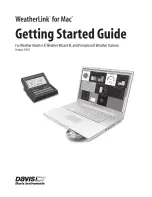
Section 8. Operation
495
8.8.1.1.4 USB: Drive
USB: drive uses
Flash
(p. 584)
memory on a Campbell Scientific mass storage
device. See
Mass Storage Devices — List
(p. 661).
Its primary purpose is the
storage of ASCII data files. Measurement data can be stored on USB: as discrete
files by using the
TableFile()
instruction. See
Table: TableFile() Instruction Data
File Formats
(p. 497).
Caution
Only remove mass-storage devices when the LED is not
flashing or lit.
Do the following when using Campbell Scientific mass-storage devices:
•
Format as FAT32
•
Connect to the CR6
CS I/O
port
•
Remove only when inactive or data corruption may result
8.8.1.2 Memory Card (CRD: Drive)
Related Topics:
•
Memory Card (CRD: Drive) — Overview
(p. 86)
•
Memory Card (CRD: Drive) — Details
(p. 495)
•
Memory Cards and Record Numbers
(p. 500)
•
Data Output: Writing High-Frequency Data to Memory Cards
(p. 268)
•
File System Errors
(p. 512)
•
Data Storage Devices — List
(p. 661)
•
Data File Format Examples
(p. 498)
•
Data Storage Drives Table
(p. 492)
The CRD: drive uses micro SD memory cards exclusively. Its primary purpose
is the storage of data files in a compact binary format. The CR6 is equipped with
a memory card slot. Purchasing industrial grade memory cards from Campbell
Scientific is recommended. Use of consumer grade cards substantially increases
the risk of data loss.
Caution
Use care when inserting or removing memory cards.
Removing a card from the module while it is being written to can cause
data corruption or damage the card. Before removing the card, press the
eject button and wait for the LED to indicate that the card is disabled. You
then have 15 seconds to pull the card before normal operations resume.
To prevent losing data, collect data from the memory card before sending
a program to the datalogger. When a program is sent to the datalogger
all data on the memory card may be erased.
A maximum of 30 data tables can be created on a memory card.
Note
CardConvert
software, included with mid- and top-level
datalogger
support software
(p. 662),
converts binary card data to the standard
Campbell Scientific data format.
Summary of Contents for CR6 Series
Page 2: ......
Page 4: ......
Page 6: ......
Page 32: ......
Page 36: ......
Page 38: ......
Page 76: ...Section 5 Overview 76 FIGURE 20 Half Bridge Wiring Example Wind Vane Potentiometer ...
Page 80: ...Section 5 Overview 80 FIGURE 23 Pulse Input Wiring Example Anemometer ...
Page 136: ......
Page 454: ...Section 8 Operation 454 FIGURE 104 Narrow Sweep High Noise ...
Page 459: ...Section 8 Operation 459 FIGURE 106 Vibrating Wire Sensor Calibration Report ...
Page 535: ...Section 8 Operation 535 8 11 2 Data Display FIGURE 121 CR1000KD Displaying Data ...
Page 537: ...Section 8 Operation 537 FIGURE 123 CR1000KD Real Time Custom ...
Page 538: ...Section 8 Operation 538 8 11 2 3 Final Storage Data FIGURE 124 CR1000KD Final Storage Data ...
Page 539: ...Section 8 Operation 539 8 11 3 Run Stop Program FIGURE 125 CR1000KD Run Stop Program ...
Page 541: ...Section 8 Operation 541 FIGURE 127 CR1000KD File Edit ...
Page 546: ......
Page 552: ......
Page 610: ...Section 11 Glossary 610 FIGURE 137 Relationships of Accuracy Precision and Resolution ...
Page 612: ......
Page 648: ......
Page 650: ......
Page 688: ......
Page 689: ......
















































